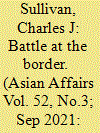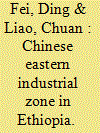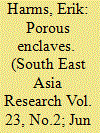| Srl | Item |
| 1 |
ID:
180305


|
|
|
|
|
| Summary/Abstract |
The deadly skirmishes along the disputed border of Kyrgyzstan and Tajikistan in late April 2021 stand out in comparison to other recent clashes between residents of this remote area. This article analyzes the 2021 border conflict. Furthermore, it stands to reason that the current political climate serves to hinder any resolution to this interstate dispute. Lastly, since skirmishes between Kyrgyzstan and Tajikistan (both members of the Collective Security Treaty Organization) serve as a source of potential embarrassment for the Russian Federation, Moscow will seek to assert its leverage, in the hopes of avoiding future clashes and maintaining its hegemony over Central Asia.
|
|
|
|
|
|
|
|
|
|
|
|
|
|
|
|
| 2 |
ID:
171316


|
|
|
|
|
| Summary/Abstract |
This paper examines China’s engagement with Africa through economic zones (EZs). It moves beyond the conceptualisation of EZs as undifferentiated enclaves of foreign investment to a dynamic perspective on the locally negotiated process of zone development. Such a perspective entails critical unpacking of the specific zone regime to understand the diverse and evolving relationships among different state and non-state actors. Drawing upon empirical research on the Eastern Industrial Zone (EIZ) in Ethiopia, we explore the complex process of learning and adaptation by government, developers, investors, and workers throughout the development of a zone regime, with specific attention to capital–labour and expatriate–local relations. We find that despite the EIZ being a state-level cooperation project, private Chinese developers work diligently with the Ethiopian government to improve the institutional support for EZs. Chinese investors also collectively generate a management regime to enhance their overseas operational capacity and experiment with various tactics to transform local recruits into an industrial workforce. Local workers, with limited protection by official labour unions, turn to individual- and group-based agency to improve their working conditions. Despite the momentum created by multiple stakeholders, there are concerns regarding the long-term contributions of EZs to engender sustained industrial transformation and skills development.
|
|
|
|
|
|
|
|
|
|
|
|
|
|
|
|
| 3 |
ID:
140849


|
|
|
|
|
| Summary/Abstract |
Cities across Asia are increasingly dotted with large, upmarket, seemingly homogeneous and avowedly exclusive master-planned, mixed-use housing and commercial developments. From an outsider's perspective, these projects appear starkly uniform and to have been imposed on urban landscapes with little attempt to integrate them into local social, cultural and economic contexts. Recent research in South East Asia, however, shows how these developments are not in fact hermetically sealed from the surrounding world. Instead, they may be productively understood as 'porous enclaves', spaces marked not only by exclusion but by social interaction that cuts across the interfaces of inside and outside, public and private, city and country and local and foreign – all categories presumed to be kept separate in many modern city plans. This introductory article to this special issue on 'Porous enclaves' highlights new research at the interface of the porous city and the enclave, and calls on urban studies scholars to pay close attention to the social life within and among the porous enclaves that have emerged in South East Asia.
|
|
|
|
|
|
|
|
|
|
|
|
|
|
|
|